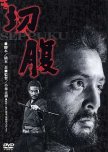Our own inner demons.
Besides Akira Kurosawa and Yasujirô Ozu, there is one more influential director in Japanese filmmaking and the world. And he is Masaki Kobayashi. In terms of genre, samurai is a sub-element of a genre. It’s not a genre but a side element of a movie. It’s like westerns but the genre has its own genre, not sub-genre. People know Kobayashi with his work “The Human Condition” trilogy. He also worked on “Samurai Rebellion”, one of the best samurai films as well. Yet, “Harakiri” was also one of the best of all time.
“Harakiri” captures an innocent life, our ancestors passed down hereditary. Difficulties in the economy and also in finding work have existed even in modern times. But, the Japanese are so afraid of being ashamed, ashamed of failure, ashamed of status, and ashamed because of so. Therefore, they don’t want to live ashamed forever. They just want to end their lives with respect by doing harakiri. However, harakiri isn’t as easy as it imagines, not just stabbing our vital and stomach. So that many consider our actions to be condemned, then we must borrow a clan’s place. Many clans refused because just doing harakiri must have an exchange.
Masaki Kobayashi always criticized and explored deeper about a Bushido Code, a Japanese collective term of honor and idealism. And one of them, besides “The Human Condition”, which is led to World War II, is “Harakiri”. This movie is about honorarium, loyalty, evaluability, in situations where the values of humanism have been abandoned. It’s more like an anti-samurai movie with humanitarian values and the Bushido Code, but more to a different perspective. However, we witnessed it as a witness. One of the members of the Iyi clan witnessed the same story as the main character.
Similar to Kurosawa’s “Rashomon” where the scene, both, opened with a man located or coming at a gate. In the view of Nakadai’s Tsugumo, we know that the story of the main character indeed real and correct. Just as he shows evidence from three master swordsmen’s hair. But, we see this view from Kagyu Saito (Rentarô Mikuni). He trying to exploit Tsugumo and Chijiwa himself. Still, he assumes this is all just for the sake of the clan. On the other side, Tsugumo tells the story in so many details, reveal isn’t Saito who only saw harakiri.
There is a scene when Tsugumo interrupted the action. It’s not because he was scared or whatever, he just wanted to choose the master swordsman to beheaded him. Since we never know what Tsugumo was like, he seems like he is the mastermind. He controls all of these situations from the beginning. He has control but doesn’t have enough strength because we know how he will end up. Tsugumo’s ideal of philosophy reflects on its own way. To conclude, he always prevents and avoids the actions of his opponent. So, he would take any chance, to begin with, death in a respectful way.
This is a black and white movie, taking lots of beautiful pictures, the point of view shot, with a lot of attention in the corner. Like watching an old painting, painted by hand and watercolor. In fact, the harakiri scene itself looks terrifying not because it feels but because of the empathy and emotion. “Harakiri” involves cultural values, the sentiments of life, and the purpose of doing harakiri. Is it for an image? Are there other meanings? Or is the impulse from the guidance of tradition forcing people to do it?
There are not many action scenes besides the magnificent duel scene and the great swordplay scene. Both of the scenes use hand-held cameras, have patterns, and are resistant to the Tsugumo’s point of view. However, we often look at Saito’s first-person view, like he listens to Tsugumo’s story or because he is the highest in his clan.
“Harakiri” shows the pain of reality, harakiri culture, and Japanese culture into the minds of viewers, raising many questions while interpreting the symbol of the tradition. There is a parallel, creating a symbol of exposition from a different perspective but we still see him as we listen to him. Easy to draw a line, with more political debates about morality. There is a good reason why humans suffer too deeply. Because, as we know, especially in this pop culture era, samurai isn’t just about sword and sword. It’s about identity, personality, and a sense of Japanese discipline towards themselves; for the sake of the name, for the sake of the clan, in order to maintain honor and dignity.
“Harakiri” captures an innocent life, our ancestors passed down hereditary. Difficulties in the economy and also in finding work have existed even in modern times. But, the Japanese are so afraid of being ashamed, ashamed of failure, ashamed of status, and ashamed because of so. Therefore, they don’t want to live ashamed forever. They just want to end their lives with respect by doing harakiri. However, harakiri isn’t as easy as it imagines, not just stabbing our vital and stomach. So that many consider our actions to be condemned, then we must borrow a clan’s place. Many clans refused because just doing harakiri must have an exchange.
Masaki Kobayashi always criticized and explored deeper about a Bushido Code, a Japanese collective term of honor and idealism. And one of them, besides “The Human Condition”, which is led to World War II, is “Harakiri”. This movie is about honorarium, loyalty, evaluability, in situations where the values of humanism have been abandoned. It’s more like an anti-samurai movie with humanitarian values and the Bushido Code, but more to a different perspective. However, we witnessed it as a witness. One of the members of the Iyi clan witnessed the same story as the main character.
Similar to Kurosawa’s “Rashomon” where the scene, both, opened with a man located or coming at a gate. In the view of Nakadai’s Tsugumo, we know that the story of the main character indeed real and correct. Just as he shows evidence from three master swordsmen’s hair. But, we see this view from Kagyu Saito (Rentarô Mikuni). He trying to exploit Tsugumo and Chijiwa himself. Still, he assumes this is all just for the sake of the clan. On the other side, Tsugumo tells the story in so many details, reveal isn’t Saito who only saw harakiri.
There is a scene when Tsugumo interrupted the action. It’s not because he was scared or whatever, he just wanted to choose the master swordsman to beheaded him. Since we never know what Tsugumo was like, he seems like he is the mastermind. He controls all of these situations from the beginning. He has control but doesn’t have enough strength because we know how he will end up. Tsugumo’s ideal of philosophy reflects on its own way. To conclude, he always prevents and avoids the actions of his opponent. So, he would take any chance, to begin with, death in a respectful way.
This is a black and white movie, taking lots of beautiful pictures, the point of view shot, with a lot of attention in the corner. Like watching an old painting, painted by hand and watercolor. In fact, the harakiri scene itself looks terrifying not because it feels but because of the empathy and emotion. “Harakiri” involves cultural values, the sentiments of life, and the purpose of doing harakiri. Is it for an image? Are there other meanings? Or is the impulse from the guidance of tradition forcing people to do it?
There are not many action scenes besides the magnificent duel scene and the great swordplay scene. Both of the scenes use hand-held cameras, have patterns, and are resistant to the Tsugumo’s point of view. However, we often look at Saito’s first-person view, like he listens to Tsugumo’s story or because he is the highest in his clan.
“Harakiri” shows the pain of reality, harakiri culture, and Japanese culture into the minds of viewers, raising many questions while interpreting the symbol of the tradition. There is a parallel, creating a symbol of exposition from a different perspective but we still see him as we listen to him. Easy to draw a line, with more political debates about morality. There is a good reason why humans suffer too deeply. Because, as we know, especially in this pop culture era, samurai isn’t just about sword and sword. It’s about identity, personality, and a sense of Japanese discipline towards themselves; for the sake of the name, for the sake of the clan, in order to maintain honor and dignity.
Was this review helpful to you?





